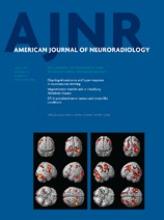Index by author
Yamamoto, A.
- BrainYou have accessVisualization of Lenticulostriate Arteries by Flow-Sensitive Black-Blood MR Angiography on a 1.5T MRI System: A Comparative Study between Subjects with and without StrokeS. Okuchi, T. Okada, M. Ihara, K. Gotoh, A. Kido, K. Fujimoto, A. Yamamoto, M. Kanagaki, S. Tanaka, R. Takahashi and K. TogashiAmerican Journal of Neuroradiology April 2013, 34 (4) 780-784; DOI: https://doi.org/10.3174/ajnr.A3310
Yamashita, Y.
- BrainYou have accessCan 3T MR Angiography Replace DSA for the Identification of Arteries Feeding Intracranial Meningiomas?H. Uetani, M. Akter, T. Hirai, Y. Shigematsu, M. Kitajima, Y. Kai, S. Yano, H. Nakamura, K. Makino, M. Azuma, R. Murakami and Y. YamashitaAmerican Journal of Neuroradiology April 2013, 34 (4) 765-772; DOI: https://doi.org/10.3174/ajnr.A3284
Yan, B.
- FELLOWS' JOURNAL CLUBExpedited PublicationYou have accessClopidogrel Hyper-Response and Bleeding Risk in Neurointerventional ProceduresC. Goh, L. Churilov, P. Mitchell, R. Dowling and B. YanAmerican Journal of Neuroradiology April 2013, 34 (4) 721-726; DOI: https://doi.org/10.3174/ajnr.A3418
Patients may respond to antiplatelet medication in 2 ways: resistance leading to higher incidence of ischemic events and hyper-response resulting in bleeds. Here, 47 patients treated with clopidogrel were tested for P2Y12 receptor-mediated platelet inhibition. Clopidogrel hyper-response was more common in patients with major (n=10) than in those with minor bleeds. Of 7 patients defined as hyper-responders, 43% had major bleeding complications. Thus, hyper-response to clopidogrel is associated with increased risk of major hemorrhage. (See the related article by Comin and Kallmes.)
Yan, F.
- Extracranial VascularYou have accessMulticenter, Intraindividual Comparison of Single-Dose Gadobenate Dimeglumine and Double-Dose Gadopentetate Dimeglumine for MR Angiography of the Supra-Aortic Arteries (the Supra-Aortic VALUE Study)Yanjun Li, X. Li, D. Li, J. Lu, X. Xing, F. Yan, Yuan Li, X. Wang, R. Iezzi and F. De CobelliAmerican Journal of Neuroradiology April 2013, 34 (4) 847-854; DOI: https://doi.org/10.3174/ajnr.A3298
Yano, S.
- BrainYou have accessCan 3T MR Angiography Replace DSA for the Identification of Arteries Feeding Intracranial Meningiomas?H. Uetani, M. Akter, T. Hirai, Y. Shigematsu, M. Kitajima, Y. Kai, S. Yano, H. Nakamura, K. Makino, M. Azuma, R. Murakami and Y. YamashitaAmerican Journal of Neuroradiology April 2013, 34 (4) 765-772; DOI: https://doi.org/10.3174/ajnr.A3284
Yeotsas, M.E.
- Pediatric NeuroimagingOpen AccessAssessment of Disease Severity in Late Infantile Neuronal Ceroid Lipofuscinosis Using Multiparametric MR ImagingJ.P. Dyke, D. Sondhi, H.U. Voss, D.C. Shungu, X. Mao, K. Yohay, S. Worgall, N.R. Hackett, C. Hollmann, M.E. Yeotsas, A.L. Jeong, B. Van de Graaf, I. Cao, S.M. Kaminsky, L.A. Heier, K.D. Rudser, M.M. Souweidane, M.G. Kaplitt, B. Kosofsky, R.G. Crystal and D. BallonAmerican Journal of Neuroradiology April 2013, 34 (4) 884-889; DOI: https://doi.org/10.3174/ajnr.A3297
Yohay, K.
- Pediatric NeuroimagingOpen AccessAssessment of Disease Severity in Late Infantile Neuronal Ceroid Lipofuscinosis Using Multiparametric MR ImagingJ.P. Dyke, D. Sondhi, H.U. Voss, D.C. Shungu, X. Mao, K. Yohay, S. Worgall, N.R. Hackett, C. Hollmann, M.E. Yeotsas, A.L. Jeong, B. Van de Graaf, I. Cao, S.M. Kaminsky, L.A. Heier, K.D. Rudser, M.M. Souweidane, M.G. Kaplitt, B. Kosofsky, R.G. Crystal and D. BallonAmerican Journal of Neuroradiology April 2013, 34 (4) 884-889; DOI: https://doi.org/10.3174/ajnr.A3297
Yoon, K.
- Pediatric NeuroimagingYou have accessAssessment of Follow-Up Sonography and Clinical Improvement among Infants with Congenital Muscular TorticollisH.-J. Park, S.S. Kim, S.-Y. Lee, Y.-T. Lee, K. Yoon, E.-C. Chung, M.-H. Rho and H.-J. KwagAmerican Journal of Neuroradiology April 2013, 34 (4) 890-894; DOI: https://doi.org/10.3174/ajnr.A3299
Yousem, D.M.
- FELLOWS' JOURNAL CLUBPractice PerspectivesYou have accessNeuroradiology Critical Findings Lists: Survey of Neuroradiology Training ProgramsL.S. Babiarz, S. Trotter, V.G. Viertel, P. Nagy, J.S. Lewin and D.M. YousemAmerican Journal of Neuroradiology April 2013, 34 (4) 735-739; DOI: https://doi.org/10.3174/ajnr.A3300
These authors questioned neuroradiology fellowship programs about the availability of “critical findings” lists and, if available, how these are distributed to trainees and whether they were vetted by corresponding clinical departments. Over one-half of programs responded and 41% had such lists. The lists were distributed during orientation, sent or made available electronically, and posted in work areas. Less than 25% of lists were developed with input from other departments. The most common entities found in the lists were: brain hemorrhage, acute stroke, cord compression, brain herniation, and spine fracture.








